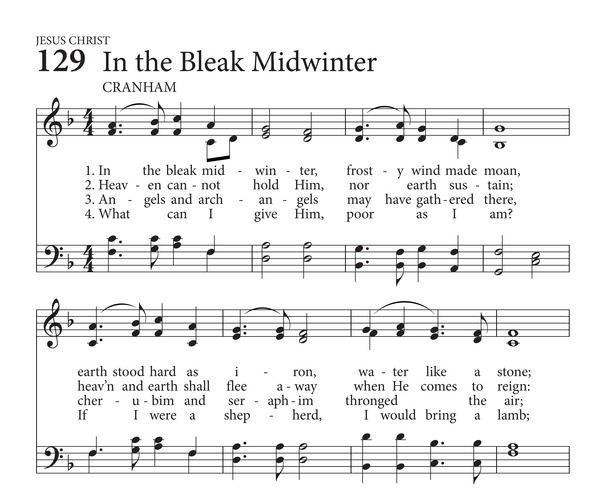All Glory, Laud, and Honour
- Fr. Scott Haynes

- Apr 4, 2022
- 3 min read
"All Glory, Laud and Honour" is an English translation by the Anglican clergyman John Mason Neale of the Latin hymn Gloria, laus et honor, which was written by Theodulf of Orléans in 820.[1] It is a Palm Sunday hymn, based on Matthew 21:1–11 and the occasion of Christ's triumphal entry into Jerusalem.[2]
Theodulf became the Bishop of Orléans under Charlemagne. When Charlemagne died and Louis the Pious became the emperor of the Holy Roman Empire, Theodulf was removed from the bishopric and placed under house arrest at a monastery in Angers during the power struggle following Louis' ascension, mostly due to his opposition to icons and Louis' suspicion that Theodulf supported an Italian rival to the throne.[3] During his arrest, Theodulf wrote "Gloria, laus et honor" for Palm Sunday. Although likely apocryphal, a 16th-century story asserted that Louis heard Theodulf sing "Gloria, laus et honor" one Palm Sunday, and was so inspired that he released Theodulf and ordered that the hymn be sung thereafter on every Palm Sunday.[4][5]
A translation into Middle English was effected by William Herebert: "Wele, herying and worshipe be to Christ that dere ous boughte,/ To wham gradden 'Osanna' children clene of thoughte." In 1851, John Mason Neale translated the hymn from Latin into English to be published in his Medieval Hymns and Sequences. Neale revised his translation in 1854 and revised it further in 1861 when it was published in the first edition of Hymns Ancient and Modern.[2]
The hymn was originally made of thirty-nine verses however only the first twelve lines were sung since a ninth-century published manuscript attributed to St. Gall until Neale's translation.[2] The original Latin words are used by Roman Catholics alongside the English translation.[6]
Hymn Text
All glory, laud, and honour
To Thee, Redeemer, King!
To Whom the lips of children
Made sweet Hosannas ring.
Thou art the King of Israel
Thou David's Royal Son,
Who in the LORD'S name comest,
The King and Blessèd One.
All glory, laud, and honour
To Thee, Redeemer, King!
To Whom the lips of children
Made sweet Hosannas ring.
The company of Angels
Is praising Thee on high,
And mortal men, and all things
Created make reply.
All glory, laud, and honour
To Thee, Redeemer, King!
To Whom the lips of children
Made sweet Hosannas ring.
The people of the Hebrews
With palms before Thee went
Our praise and prayers and anthems
Before Thee we present.
All glory, laud, and honour
To Thee, Redeemer, King!
To Whom the lips of children
Made sweet Hosannas ring.
To Thee before Thy Passion
They sang their hymns of praise;
To Thee now high exalted
Our melody we raise.
All glory, laud, and honour
To Thee, Redeemer, King!
To Whom the lips of children
Made sweet Hosannas ring.
Thou didst accept their praises;
Accept the praise we bring,
Who in all good delightest,
Thou good and gracious King.
All glory, laud, and honour
To Thee, Redeemer, King!
To Whom the lips of children
Made sweet Hosannas ring.[5]
Notes
Theodulf became the Bishop of Orléans under Charlemagne.
^ a b c "All Glory, Laud and Honor". Hymnary.org. Retrieved 2014-03-14.
^ "In context: All Glory, Laud and Honor". Christian History Institute. Retrieved 2014-04-07.
^ Petersen, Randy (2014). Be Still, My Soul: The Inspiring Stories behind 175 of the Most-Loved Hymns. Tyndale House Publishers. p. 13. ISBN 141438842X.
^ a b "Psalter Hymnal (Gray) 375. All Glory, Laud, and Honor". Hymnary. Retrieved 2014-04-07.
^ "Hymn: Gloria Laus et Honor (All Glory, Laud and Honor)". Catholic Culture. Retrieved 2014-03-14.
^ For a full translation of the most commonly sung Latin verses, see John Mason Neale (1867). "Gloria, laus, et honor". Mediæval Hymns and Sequences (3rd ed.). London: Joseph Masters and son. pp. 23–26.
^ Nutter, Charles S.; Tillett, Wilbur Fisk (1911). The hymns and hymn writers of the church; an annotated ed. of The Methodist hymnal. New York, Methodist Book Concern. pp. 22, 473.
^ Graves, Dan. "All glory, laud, and honor | InContext". Christian History Institute.



Comments